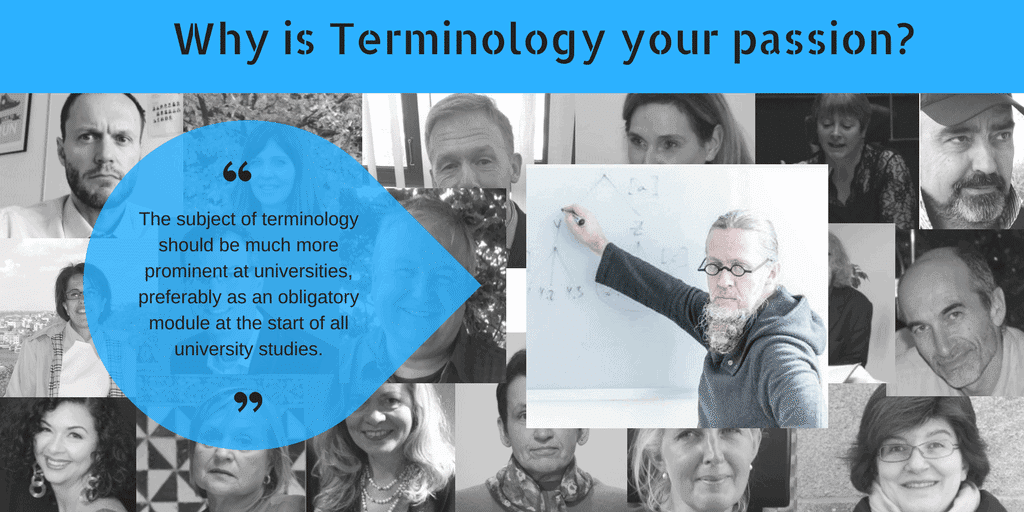Interview with Terminologist Henrik Nilsson
Henrik Nilsson, born in 1970, has been working as a terminologist at the Swedish Centre for Terminology (Terminologicentrum TNC) since 1997. At the centre, he worked with Eurodicautom and he participated in one of the working groups during the development of the IATE database of the European Commission, a software he later evaluated within the national project preparing a national terminological infrastructure in Sweden (named TISS). Within TNC, he has taken part in various terminology projects and he directs the joint group for life sciences terminology and a termbank for the planning and building sector. He has also been responsible for marketing activities and was the web editor of TNC’s website. He has been responsible for the contents and marketing of the national termbank, Rikstermbanken. He also teaches terminology to various groups (students at universities, employees at various private companies and public authorities) and he often presents papers at national and international conferences (EAFT Summit, TKE, LSP). He has contributed articles to the Handbook of Terminology (vol. 1) and Terminology in Everyday Life, both published by Benjamins. He has been part of the board of the EAFT for many years and is currently its President. He holds a diploma in Communication Science, English and French and he is also a trained English teacher. Since 2018, he has been working as a terminologist for the newly started C.A.G Next, part of the C.A.G group.
1. Why is terminology so important in the field of translation? Why is it also important in our daily life?
We all come into contact with terminology at certain times and in certain situations, and when we do, we need to know how to deal with it. And we should not dread it – there is so much to discover and learn from experts in various fields, and this is also true when it comes to their use of language. That terminology is important for translation has been shown in surveys where translators estimate that a substantial amount of their working time is spent doing terminology work. When you add more than one language, the situation becomes more complex, and there are many aspects of terminology and translation that are yet to be studied. A structured approach to handling terminology is not only a problem-solving tool which helps translators find the right equivalent – terminology management can also be thought of as a method and a way of thinking which I believe is beneficial in many contexts for translators, both in their professional capacity and in their everyday life.
2. In the past you have spoken about the responsibility of the translator working as a terminologist. What responsibility do you think the terminologist bears?
I find the idea of “terminological responsibility” very interesting to think about. Of course, this entails self-reflection on the role of the terminologist and the contribution this profession can make to solving issues and facilitating consensus in a group. The profession of terminologist can be divided into several types which affect the responsibility: if a terminologist is also an expert in the field in question, the corresponding responsibility would be similar to that of another expert – to contribute and listen to other opinions with the aim of achieving a joint goal. But in other cases, and perhaps more commonly, the terminologist would not be a domain expert and so the responsibility would include being well-prepared (having at least attempted to study the domain in question to some extent) but also to use the terminological mind and method to see the structure and ask the questions needed. Furthermore, the terminologist should know what method to use in what context, be able to co-operate with related professions, constantly follow developments in the theory and practice of terminology, and know what sources to use and when. And finally, always be prepared to spread the word about terminology wherever this is still unknown territory!
3. From your experience of teaching terminology: how does one teach terminology? Is it difficult to convince professional linguists – translators or interpreters – that it is important?
The didactics of terminology is also an interesting area which should be discussed more. Overall, the subject of terminology should be much more prominent at universities, preferably as an obligatory module at the start of all university studies. In my experience, some aspects of terminology actually come more naturally to non-linguists, especially to professionals used to thinking in hierarchies and logical structures. Translators and interpreters are often the only professional groups who, in many countries, get some terminology training and normally they quickly see the use and are easy to “convince”. However, there can at times be too much focus on the linguistic side compared to the cognitive, conceptual side of the work. There are also other professional groups, often with a background in IT, who have started working with some aspects of terminology, e.g. system and enterprise architects, demands analysts and health informatics specialists – and this tendency will also affect how the subject of terminology is and will be taught.
4. In 2016, the European Association for Terminology (EAFT) celebrated its 20th anniversary. In your own opinion, how has its approach to terminology changed over these twenty years?
Some topics are as relevant today as they were 20 years ago – I tend to reuse more and more older material (even from the 1800s!) since it is still relevant and well worded. But as in many other areas, we have also seen a development in terminology which has turned it into something more technical, more text-oriented and more cognitive and ontological in nature than before, which is in itself a very interesting development. The general aim of the EAFT, of gathering organizations and individuals, and promoting the area of terminology at all levels of society in Europe, has remained the same, and the Brussels Declaration is still valid and relevant. The Association has also taken a stance and protested against the closing of terminology programmes, and we also try to embrace other developments, e.g. the use of social media which means quicker and more direct contacts with members and “terminology lovers”.
5. Can you give us some details about your role as the president of EAFT and as a member of the Swedish Centre for Terminology (Terminologicentrum TNC)?
I feel very European and very Scandinavian at the same time, which I think can be a good thing. To me, the role of the EAFT President is to create a functioning board and to be a missionary on the European level, visiting institutions and constantly doing promoting and lobbying activities. On the national level, at TNC, I have been one of several terminologists, from whom I learned a lot during some 20 years. I have been lucky to have a very varied line of work covering terminology teaching, smaller and bigger projects, termbank management, terminology planning, research, translation and documentation.
6. You mentioned that the TNC is 75 years old. Where do you see EAFT in 55 years? Where do you hope to see terminology go in that time?
Currently, we are seeing some negative developments, with the closing or reorganization of many institutions, and some major terminological events are not happening as frequently as before, so in 55 years I hope the EAFT will be as strong as ever, functioning as a truly European platform, joining together organizations and individuals working in terminology. I do hope that the SIGs (special interest groups) will return so that there will also be some hands-on work and exchange of experiences, especially related to research and teaching. It all comes down to the persistence of those working in and with the organization, and in my experience, terminologists are those kinds of people.
7. You can proudly call yourself one of the creators of the original IATE. What were the main ideals and goals for its creation? Do you think they have been fulfilled?
I wouldn’t call myself a creator, but I hope that I helped a little bit in its creation. I was in the workflow group together with many skilled people, and I remember that there were many varied demands on this joint endeavour. Looking at the result, I feel it has succeeded. Of course, technology has developed in the meantime, creating new possibilities, not really imaginable at the time. Then again, a termbank is never finished, and I think the IATE team are well under way to adapt to new creative ideas and developments.
8. Could you tell us a little bit about the collaboration between EAFT and IATE?
The collaboration has been intensified with TermCoord and we have had several interesting contributions related to IATE at the Summits. One aim is to provide something useful for all the translators and terminologists, especially within the EU. And considering that IATE is still the biggest European terminological resource, we try to find opportunities to inform people about it and its development. I have also had the opportunity to give seminars and courses at the EU institutions and I especially remember my “Red and Green seminar” devoted to IATE, where all the participants got voting cards, which they used to answer questions related to IATE.
9. Every year, EAFT grants an award for the Best Thesis on Terminology. Can you tell us more about this initiative and how it is helping to spread terminology awareness?
There are two International Terminology Awards (ITAs): the International Award for Distinguished Achievement in Terminology (MA level) and the International Award for Outstanding Achievement in Terminology Research and Development (PhD level). These awards are given to researchers in line with the mission of EAFT, which is: “the promotion of and support for research in terminology and related issues; contributions to the education and training of people working with terminology in all capacities, and the formal recognition of academic and vocational terminological training courses at the European and national levels.”
10. From 14th to 15th November 2016, EAFT (in collaboration with TermCoord), organised the VIII European Terminology Summit ‘Visions and Revisions’ in Luxembourg. Can you tell us how successful you think the event was and what were the results that came from the summit?
Overall, I think the idea of self-reflection and looking backwards and forwards was a good choice. Collaborating with TermCoord at the very heart of Europe made the event stronger and when I think about it, I feel proud and happy. There were many interesting contributions and the mood was positive – especially during a conference dinner where everyone squeezed into a little Greek restaurant. We also realized that the Brussels Declaration is still valid. I constantly think about the Summit’s structure, and how it can be developed and given a new twist, and I think the introduction of a laid-back discussion with the previous Presidents was a fun idea in 2016 – as was the PechaKucha-session we did in 2014. The Summit shows the extent of EAFT and terminology, and everything that can be achieved with relatively little means, and a lot of hard work by dedicated people. For one Summit, we did a yoyo which shows that you also need a sense of humour!
Interviewer: Anna Wawrzonkowska
Former trainee at TermCoord, DG TRAD at the European Parliament
Italian and Linguistics at the University of Oxford, Oriel College
This post originally appeared on Termcoord



















